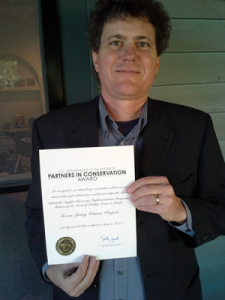
By Damien Brockmann
Lone Star Sierra Club's Tyson Broad among the recipients in Washington
Last week, the Secretary of the Interior Sally Jewell presented the Department’s 2013 Partners in Conservation awards at a ceremony in Washington, DC where she honored 20 partnership projects that have demonstrated exemplary natural resource conservation efforts through public-private cooperation. In Texas, the 2013 award went to the Edwards Aquifer Recovery Implementation Program (EARIP)– a program that resulted in large part from several decades of work by the Lone Star Chapter of the Sierra Club to raise awareness of issues surrounding development around of the Edwards Aquifer and protect the endangered and threatened species that depend on its springflows.
“We are extremely proud of the work we have put into protecting the Edwards Aquifer. It has been a long struggle over several decades and involved the efforts of countless advocates and supporters,” Sierra Club Lone Star Chapter Director Scheleen Walker said. “We especially appreciate the tireless work of our Research Associate Tyson Broad, one of [last week]’s individual recipients in D.C. who has worked on the Edwards Aquifer Recovery Implementation Program since its inception in 2007.”As the Sierra Club’s Research Associate, Tyson Broad has worked on the project for over seven years, partnering with organizations that did not always see eye-to-eye.“There were times when it felt like the wheels were about to come off,” Broad said, commenting on his seven years working with EARIP. “When you work with a group of people for so long, you want to have a result. If we didn’t come up with something, we would be back to square one.”“You work through the disagreements, and over time, understand where your opponents are coming from and learn how to work through those issues together. As a result of that work, we not only have a program that works to protect the Aquifer, but we also have stronger relationships. Today, those of us who worked together on this have a better ability to call each other and work on other issues.”In the early 1990s, the Sierra Club filed a lawsuit against the U.S. Fish & Wildlife Service (USFWS) in federal court for its failure to develop a recovery plan to protect endangered and threatened species at Comal and San Marcos Springs, the discharge points for the Aquifer. The lawsuit argued that the rising and falling of aquifer levels affect the flows necessary to maintain the species at the springs and that under the Endangered Species Act the USFWS had a legal obligation to coordinate management of the Aquifer.The Sierra Club won the lawsuit in 1993 , and the federal judge gave the Texas Legislature time to enact legislation to regulate withdrawals of groundwater from the aquifer to protect aquifer levels and springflows. The Legislature responded by creating the Edwards Aquifer Authority (EAA) which placed a cap on groundwater withdrawals.Coupled with the creation of the EAA was a requirement that a plan be developed for maintaining springflows and protecting the species by 2012. In 2007, following an initiative from the USFWS, the Legislature adopted a process for the preparation of a recovery implementation plan for the species. That led to the creation of a group of diverse stakeholders whose completion of a consensus plan for species recovery was recognized by the U.S. Secretary of the Interior. The Sierra Club was an active participant in that process.Located at the edge of the Texas hill country, the Edwards Aquifer is considered one of the most biologically diverse aquifers in the world. The Edwards Aquifer is home to species found nowhere else in the world, including eight species that are listed under the Endangered Species Act. This prolific aquifer is also the source of the two largest springs in Texas and perhaps the Southwestern US – the San Marcos and the Comal springs – which flow into the Guadalupe River, ultimately providing freshwater inflows to the Aransas National Wildlife Refuge, home to the Whooping Crane.
For over a century, the Edwards Aquifer has provided clean drinking water to more than 2 million residents of San Antonio, the nation’s seventh largest city, in addition to providing water for farming and ranching communities, the rapidly growing cities of New Braunfels and San Marcos, and communities downstream of the springs all the way to the Gulf of Mexico.